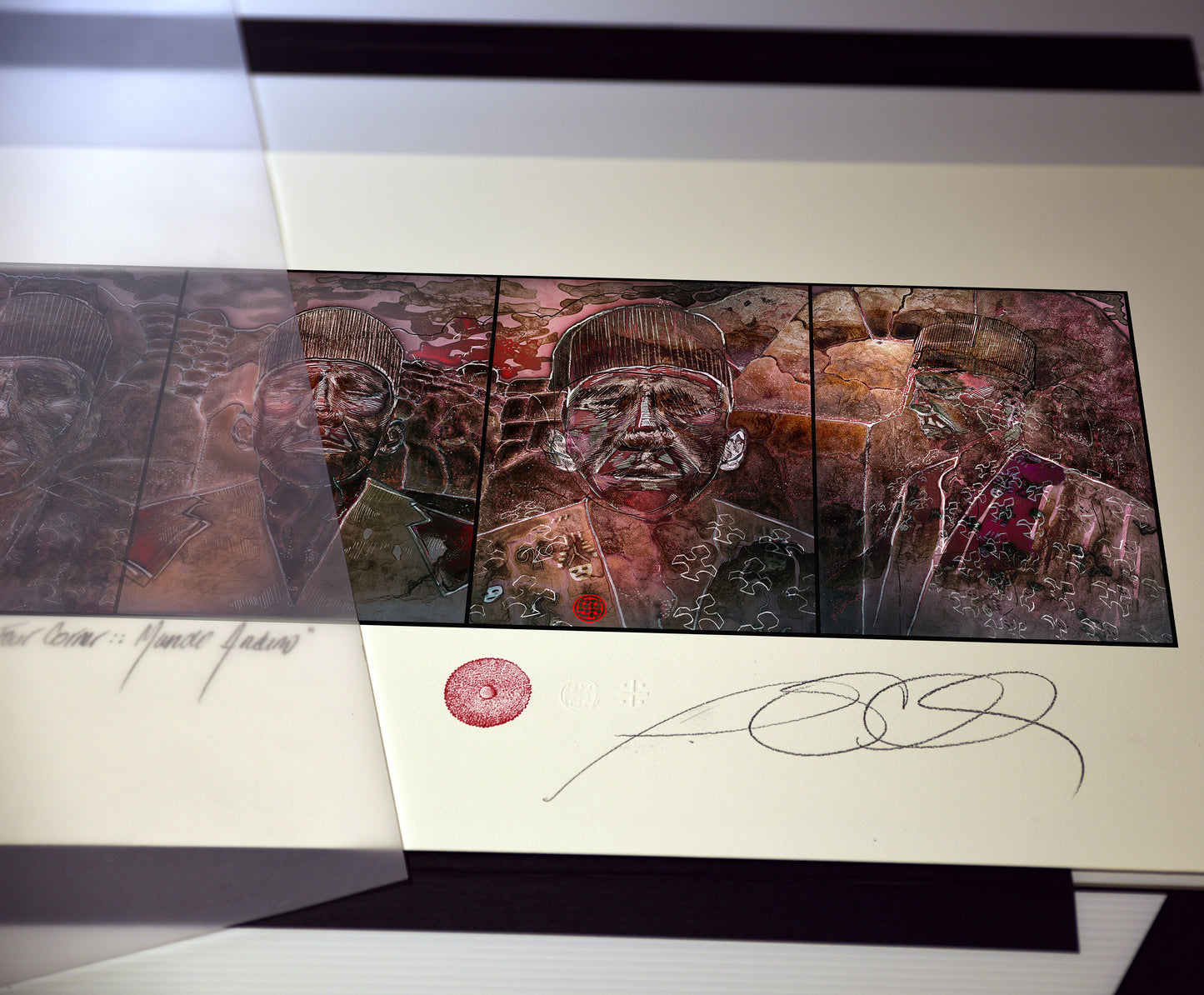sutulov online
FOUR CORNER :: MUNDO ANDINO / Study I
Couldn't load pickup availability
Iconographic Construction: five-color lithographic mylar
Image Size: 8 x 27 1/2 inches
Marks: edition number, title, series stamp, edition, artist chop, and artist signature.
Presentation: hardcover portfolio with archival separation sheet.
Description:
Depiction of Inca dignitaries who are distinguished by their ceremonial garments known as Unku. A short vest of elaborate design describing the archetypes of said lord of the Andes. The work is focused on the Amano Collection, one of the wealthiest PreColombian collections in the world.
Edition
Edition
BAT (Bon-a-Tirer) 1
Printer's Proof 1
Artist Proof 8
Edition of 40
Shipping & Handling
Shipping & Handling
All editions are shipped in a 3/16 inch black gator board flat portfolio with acid-free separation sheets and boxed with protection foam approved by most major air and ground carriers, including UPS and FedEx®.
Certificate of Authenticity
Certificate of Authenticity
All editions come with documentation with a complete description of the print's genesis and stage work. This information is critical in authenticating the processes that require meticulous production.
The acid-free heavy stock board document, embellished with Atelier's silver foil seal, is unique, granting them work's added value. Said certificate of authenticity also includes the artist's signature, chop, and edition chop marks.
Care Instructions
Care Instructions
Improper framing can permanently damage your print; a professional framer that uses archival materials is essential.
A window mat is a matter of personal taste. Often a print with a border is hinged to a backing-this is called "floating" the print- and requires a spacer, hidden by the edges of the frame, to keep the print from touching the Glass in the same way that a window mat does. A window mat may cover the edges of the paper if you prefer (although the edges are considered to be an integral part of the print), or the print may float within the window.
Prints are never glued or taped directly to a backing with pressure-sensitive tapes; hinges made of linen or fine Japanese paper hold the print to the backing with non-acidic, non-staining, reversible adhesives.
Both glass and acrylic sheeting (plexiglass) condense moisture from the air; if your print touches either, it may actually stick to the surface and be ruined.
Both will protect your print and filter some of the harmful rays of light. Glass is less expensive, but it breaks easily. Ultraviolet filtering glass and plexiglass are available at a higher cost. Since Glass is heavier than plastic, it may be impractical for very large prints. Plexiglass, although lighter, is more expensive than ordinary Glass, scratches easily, and carries an electrostatic charge that causes it to attract dust.
Bright daylight and artificial light can cause colors to fade and papers to discolor and become brittle. Too much light is harmful even when ultraviolet rays are filtered out, so make sure your print is exposed only to moderate light for limited hours at a time. You might also consider rotating your prints from time to time.
When handling unframed prints, make sure you work with gloves or clean hands. Finger smudges, dirt, or dents and tears caused by carelessness will affect the value of your print. If you must handle your print, lift it by diagonally opposite corners to avoid creasing. Prints should be stored flat, either in or out of archival mats, layered between sheets of non-acidic interleafing tissue.
Ever store your prints against surfaces such as corrugated board or wood; not only are the materials acidic, they also have textures that can imprint themselves on your artwork.
Your storage area should be clean, dry, and protected from insects and vermin. Roaches, silverfish, and mice are common despoilers of paper. Simple, relatively inexpensive non-acidic boxes will protect your prints from environmental damage; they are available from art and preservation suppliers.







FOUR CORNER :: MUNDO ANDINO
From the Tiwanaku in the Andean Plateau to the Molle Culture in Northern Chile, sun cultures emerged in the Andean Four Corners. The conjunction with Southern Peru, Southern Bolivia, Northern Chile, and Northern Argentina, Atelier Alexander Sutulov focuses on archeological sites that testify to the universe's origin.
Add a tagline
-

FOUR CORNER :: a challenge in itself
Our Four Corner project has extended to the origin of PreColombian cultures in South America. Following the path of the Llama Trail, these sun cultures have created a network of solar maps that key to several hieroglyphs, which entail the mysteries of an ancient civilization. All the pertaining editions are different instances that brought together these remarkable historical records.
-

Wari :: lords of the Andes
"Eminent ancestors of the better-known Inca, the Wari ascended to power in the south-central highlands of Peru in about AD 600, underwent a period of explosive growth, and then, by AD 1000, collapsed. During this lifespan, they created a society of such unprecedented complexity that many today regard it as the first empire in the Andes. Elite arts and the ideologies that informed them were among the culture's mostprominent exports.








